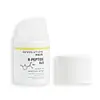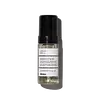What's inside
What's inside
 Key Ingredients
Key Ingredients

 Benefits
Benefits

 Concerns
Concerns

 Ingredients Side-by-side
Ingredients Side-by-side

Water
Skin ConditioningAlcohol Denat.
AntimicrobialCetearyl Alcohol
EmollientPropanediol
SolventBehentrimonium Chloride
PreservativePolysorbate 20
EmulsifyingArginine Hcl
Skin ConditioningDicaprylyl Ether
EmollientCetyl Alcohol
EmollientIsododecane
EmollientMaleic Acid
BufferingCannabis Sativa Seed Oil
EmollientParfum
MaskingButylene Glycol
HumectantHydrogenated Polydecene
EmollientPhenoxyethanol
PreservativeDimethicone
EmollientBis-PCA Dimethicone
Glycerin
HumectantIsopropyl Alcohol
SolventSodium Hydroxide
BufferingSodium PCA
HumectantAminomethyl Propanol
BufferingSodium Lactate
Buffering4-PCA Dimethicone
Skin ConditioningDisodium PEG-12 Dimethicone Sulfosuccinate
CleansingStearyl Alcohol
EmollientEthylhexylglycerin
Skin ConditioningArginine
MaskingAspartic Acid
MaskingPCA
HumectantChenopodium Quinoa Seed Extract
Skin ConditioningGlycine
BufferingAlanine
MaskingSerine
MaskingValine
MaskingCopper Tripeptide-34
Skin ConditioningProline
Skin ConditioningThreonine
Isoleucine
Skin ConditioningPotassium Sorbate
PreservativeSodium Benzoate
MaskingHistidine
HumectantPhenylalanine
MaskingTocopherol
AntioxidantCaprylyl Glycol
EmollientHexylene Glycol
EmulsifyingAlpha-Isomethyl Ionone
PerfumingBenzyl Benzoate
AntimicrobialEugenol
PerfumingHexyl Cinnamal
PerfumingLimonene
PerfumingLinalool
PerfumingWater, Alcohol Denat., Cetearyl Alcohol, Propanediol, Behentrimonium Chloride, Polysorbate 20, Arginine Hcl, Dicaprylyl Ether, Cetyl Alcohol, Isododecane, Maleic Acid, Cannabis Sativa Seed Oil, Parfum, Butylene Glycol, Hydrogenated Polydecene, Phenoxyethanol, Dimethicone, Bis-PCA Dimethicone, Glycerin, Isopropyl Alcohol, Sodium Hydroxide, Sodium PCA, Aminomethyl Propanol, Sodium Lactate, 4-PCA Dimethicone, Disodium PEG-12 Dimethicone Sulfosuccinate, Stearyl Alcohol, Ethylhexylglycerin, Arginine, Aspartic Acid, PCA, Chenopodium Quinoa Seed Extract, Glycine, Alanine, Serine, Valine, Copper Tripeptide-34, Proline, Threonine, Isoleucine, Potassium Sorbate, Sodium Benzoate, Histidine, Phenylalanine, Tocopherol, Caprylyl Glycol, Hexylene Glycol, Alpha-Isomethyl Ionone, Benzyl Benzoate, Eugenol, Hexyl Cinnamal, Limonene, Linalool
Water
Skin ConditioningPolysorbate 20
EmulsifyingPropanediol
SolventParfum
MaskingAlcohol Denat.
Antimicrobial1,2-Hexanediol
Skin ConditioningCoco-Betaine
CleansingPolyquaternium-11
Disodium EDTA
Polyquaternium-53
Soy Amino Acids
Skin ConditioningWheat Amino Acids
Skin ConditioningCitric Acid
BufferingGlycine
BufferingLysine Hcl
Skin ConditioningPolyester-37
Skin ConditioningPvp
Emulsion StabilisingSodium Chloride
MaskingCaprylhydroxamic Acid
Arginine Hcl
Skin ConditioningSerine
MaskingThreonine
Polyacrylamidopropyltrimonium Chloride
Polyquaternium-55
Distearyldimonium Chloride
Phenoxyethanol
PreservativeBehentrimonium Chloride
PreservativeBenzyl Alcohol
PerfumingGamma-Docosalactone
Skin ConditioningAlpha-Isomethyl Ionone
PerfumingCaprylyl Glycol
EmollientGlycine Soja Sterols
EmollientWater, Polysorbate 20, Propanediol, Parfum, Alcohol Denat., 1,2-Hexanediol, Coco-Betaine, Polyquaternium-11, Disodium EDTA, Polyquaternium-53, Soy Amino Acids, Wheat Amino Acids, Citric Acid, Glycine, Lysine Hcl, Polyester-37, Pvp, Sodium Chloride, Caprylhydroxamic Acid, Arginine Hcl, Serine, Threonine, Polyacrylamidopropyltrimonium Chloride, Polyquaternium-55, Distearyldimonium Chloride, Phenoxyethanol, Behentrimonium Chloride, Benzyl Alcohol, Gamma-Docosalactone, Alpha-Isomethyl Ionone, Caprylyl Glycol, Glycine Soja Sterols
Ingredients Explained
These ingredients are found in both products.
Ingredients higher up in an ingredient list are typically present in a larger amount.
Alcohol Denat. is an alcohol with a denaturant property. It is created by mixing ethanol with other additives.
This ingredient gets a bad rep because it is irritating and drying - mostly due to its astringent property. Astringents draw out natural oils in tissue, constricting pores and leaving your skin dried out.
However, alcohol denat. is not all that bad.
Due to its low molecular weight, alcohol denat. tends to evaporate quickly. One study on pig skin found half of applied alcohol evaporated in 10 seconds and less than 3% stayed on skin.
This also helps other ingredients become better absorbed upon application.
Studies are conflicted about whether this ingredient causes skin dehydration. One study from 2005 found adding emollients to propanol-based sanitizer decreased skin dryness and irritation. Another study found irritation only occurs if your skin is already damaged.
Small amounts of alcohol are generally tolerated by oily skin or people who live in humid environments.
The rule of thumb is if this alcohol is near the end of an ingredients list, it will probably not affect your skin much.
Also...
This ingredient has antimicrobial and solvent properties.
The antimicrobial property helps preserve products and increase their shelf life. As a solvent, it helps dissolve other ingredients.
Other types of astringent alcohols include:
Learn more about Alcohol Denat.Alpha-Isomethyl Ionone is a fragrance. It can be synthetically created or naturally occurring.
The scent of Alpha-Isomethyl Ionone is described as "flowery" but can also be "woody".
Naturally occurring Alpha-Isomethyl Ionone may be found in Saccharomyces cerevisiae, or the yeast used to make wine and bread.
The term 'fragrance' is not regulated in many countries. In many cases, it is up to the brand to define this term. For instance, many brands choose to label themselves as "fragrance-free" because they are not using synthetic fragrances. However, their products may still contain ingredients such as essential oils that are considered a fragrance.
Learn more about Alpha-Isomethyl IononeWe don't have a description for Arginine Hcl yet.
This ingredient is a preservative and often used for it's anti-static properties. You'll most likely see this ingredient in hair conditioners.
It does not cause irritation or sensitization in leave-on products at 1-5%.
Caprylyl Glycol is a humectant and emollient, meaning it attracts and preserves moisture.
It is a common ingredient in many products, especially those designed to hydrate skin. The primary benefits are retaining moisture, skin softening, and promoting a healthy skin barrier.
Though Caprylyl Glycol is an alcohol derived from fatty acids, it is not the kind that can dry out skin.
This ingredient is also used as a preservative to extend the life of products. It has slight antimicrobial properties.
Learn more about Caprylyl GlycolThis ingredient is an amino acid that helps build proteins and moisturizes skin. It is already present in our skin as our bodies produce them naturally.
Glycine already plays a role in helping keep our skin moisturized as amino acids transport moisture throughout our skin.
As collagen is made up of glycine and other amino acids, it is believed glycine may help our skin produce more collagen.
Learn more about GlycineParfum is a catch-all term for an ingredient or more that is used to give a scent to products.
Also called "fragrance", this ingredient can be a blend of hundreds of chemicals or plant oils. This means every product with "fragrance" or "parfum" in the ingredients list is a different mixture.
For instance, Habanolide is a proprietary trade name for a specific aroma chemical. When used as a fragrance ingredient in cosmetics, most aroma chemicals fall under the broad labeling category of “FRAGRANCE” or “PARFUM” according to EU and US regulations.
The term 'parfum' or 'fragrance' is not regulated in many countries. In many cases, it is up to the brand to define this term.
For instance, many brands choose to label themselves as "fragrance-free" because they are not using synthetic fragrances. However, their products may still contain ingredients such as essential oils that are considered a fragrance by INCI standards.
One example is Calendula flower extract. Calendula is an essential oil that still imparts a scent or 'fragrance'.
Depending on the blend, the ingredients in the mixture can cause allergies and sensitivities on the skin. Some ingredients that are known EU allergens include linalool and citronellol.
Parfum can also be used to mask or cover an unpleasant scent.
The bottom line is: not all fragrances/parfum/ingredients are created equally. If you are worried about fragrances, we recommend taking a closer look at an ingredient. And of course, we always recommend speaking with a professional.
Learn more about ParfumPhenoxyethanol is a preservative that has germicide, antimicrobial, and aromatic properties. Studies show that phenoxyethanol can prevent microbial growth. By itself, it has a scent that is similar to that of a rose.
It's often used in formulations along with Caprylyl Glycol to preserve the shelf life of products.
Polysorbate 20 is made by combining ethoxylation of sorbitan, ethylene oxide, and lauric acid. It is a mild cleansing agent, surfactant, and emulsifier.
As a surfactant, it helps collect dirt and oils for washing. Emulsifiers prevent oils and water from separating.
Polysorbate 20 also adds scent to a product. Since it is made using sorbitol, it has a sweet scent. Sorbitol can also be found in fruits such as apples and peaches.
The lauric acid used to create Polysorbate 20 is often derived from coconuts.
Polysorbate 20 may not be fungal acne safe.
Learn more about Polysorbate 20Propanediol is an all-star ingredient. It softens, hydrates, and smooths the skin.
It’s often used to:
Propanediol is not likely to cause sensitivity and considered safe to use. It is derived from corn or petroleum with a clear color and no scent.
Learn more about PropanediolSerine is an amino acid naturally found in our body. Our bodies use amino acids to create protein.
Amino-acids help give keep our skin hydrated. They play an important role in the skin barrier, which keeps the skin plump and firm.
Serine is a non-essential amino acid, meaning we don't need to obtain it from eating foods.
Learn more about SerineThreonine is an amino-acid. It helps hydrate the skin and has antioxidant benefits.
Our skin uses threonine for creating collagen and elastin. Humans are not able to create threonine and must get it through eating foods such as fish, lentils, poultry, sesame seeds, and more.
Water. It's the most common cosmetic ingredient of all. You'll usually see it at the top of ingredient lists, meaning that it makes up the largest part of the product.
So why is it so popular? Water most often acts as a solvent - this means that it helps dissolve other ingredients into the formulation.
You'll also recognize water as that liquid we all need to stay alive. If you see this, drink a glass of water. Stay hydrated!
Learn more about Water